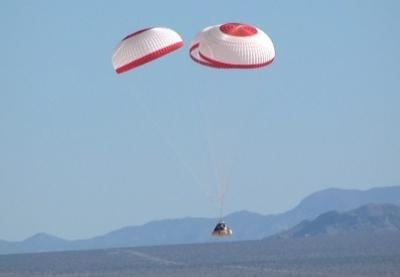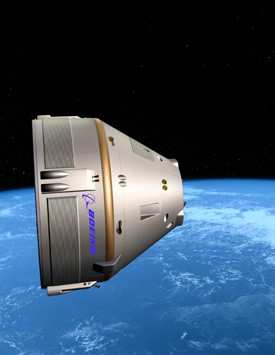Thu, Apr 05, 2012
First Test Of Fully Combined Vehicle Landing System
A parachute drop test of Boeing's Crew Space Transportation (CST)-100 spacecraft occurred Tuesday at the Delamar Dry Lake Bed near Alamo, NV. CST-100 is part of the Boeing Commercial Crew Transportation System (CCTS).

An Erickson Sky Crane helicopter lifted the CST-100 test article to about 11,000 feet and released it. Three main parachutes deployed to slow the capsule's descent before six airbags inflated, providing a smooth ground landing. The event was the first drop test of the fully combined vehicle landing system, including all elements. "This successful test is a tremendous milestone that brings Boeing one step closer to completing development of a system that will provide safe, reliable and affordable crewed access to space," said John Mulholland, vice president and program manager, Boeing Commercial Programs.
Boeing is drawing on its significant knowledge, testing and experience gained from the Apollo missions as it develops and tests the CCTS. Leveraging re-entry and ocean landing data from the Apollo program, the rigorous CST-100 landing tests will reduce risk and validate the post re-entry landing and recovery capability of this system.
As part of the Boeing Commercial Crew team, Bigelow Aerospace played a key role by providing the capsule test article and associated electronics and supporting the test itself. Bigelow Aerospace is a Boeing customer, with plans to use the CCTS for transportation to and from Bigelow on-orbit platforms. Boeing and Bigelow Aerospace are partnering to advance the commercial space market by offering opportunities for integrated transportation and on-orbit platform capabilities and services to new customers.
The team is planning a second test later this month, following parachute inspection and re-packing. This second drop test will include a drogue parachute deployment sequence on top of the main parachute deployment, demonstrating the full, nominal parachute system performance.Boeing has scheduled additional tests to be performed in 2012, including a landing air bag test series in May, a forward heat shield jettison test in June, and an orbital maneuvering/attitude control engine hot fire test in June -- all to gather additional data on key functional elements of the spacecraft design. (Images provided by Boeing)

More News
Pilot Also Reported That Due To A Fuel Leak, The Auxiliary Fuel Tanks Were Not Used On June 4, 2025, at 13:41 eastern daylight time, a Piper PA-23, N2109P, was substantially damage>[...]
Have A Story That NEEDS To Be Featured On Aero-News? Here’s How To Submit A Story To Our Team Some of the greatest new stories ANN has ever covered have been submitted by our>[...]
From 2023 (YouTube Edition): Reflections on War’s Collective Lessons and Cyclical Nature The exigencies of war ought be colorblind. Inane social-constructs the likes of racis>[...]
Aero Linx: Colorado Pilots Association (CPA) Colorado Pilots Association was incorporated as a Colorado Nonprofit Corporation in 1972. It is a statewide organization with over 700 >[...]
High Speed Taxiway A long radius taxiway designed and provided with lighting or marking to define the path of aircraft, traveling at high speed (up to 60 knots), from the runway ce>[...]
 NTSB Prelim: Piper PA-23
NTSB Prelim: Piper PA-23 ANN FAQ: Submit a News Story!
ANN FAQ: Submit a News Story! Classic Aero-TV: One Mans Vietnam
Classic Aero-TV: One Mans Vietnam ANN's Daily Aero-Linx (07.03.25)
ANN's Daily Aero-Linx (07.03.25) ANN's Daily Aero-Term (07.03.25): High Speed Taxiway
ANN's Daily Aero-Term (07.03.25): High Speed Taxiway




